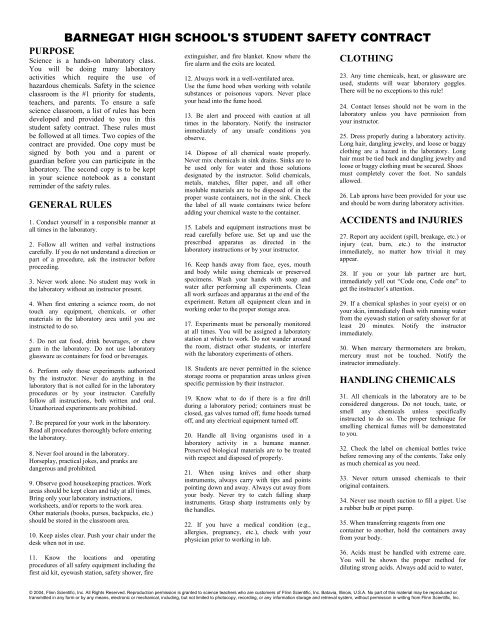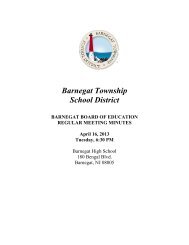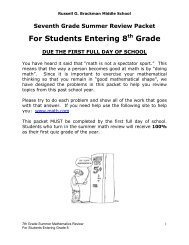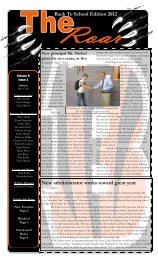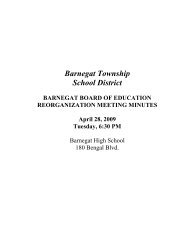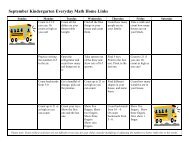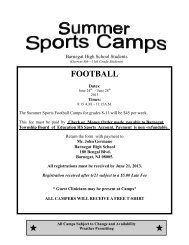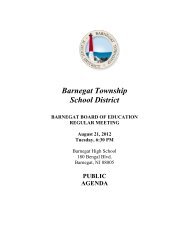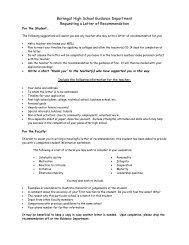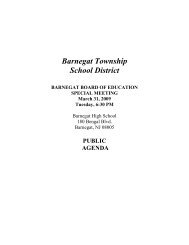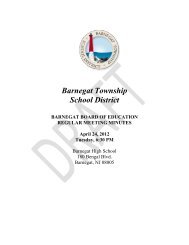BHS Lab Safety Contract
BHS Lab Safety Contract
BHS Lab Safety Contract
You also want an ePaper? Increase the reach of your titles
YUMPU automatically turns print PDFs into web optimized ePapers that Google loves.
BARNEGAT HIGH SCHOOL'S STUDENT SAFETY CONTRACTPURPOSEScience is a hands-on laboratory class.You will be doing many laboratoryactivities which require the use ofhazardous chemicals. <strong>Safety</strong> in the scienceclassroom is the #1 priority for students,teachers, and parents. To ensure a safescience classroom, a list of rules has beendeveloped and provided to you in thisstudent safety contract. These rules mustbe followed at all times. Two copies of thecontract are provided. One copy must besigned by both you and a parent orguardian before you can participate in thelaboratory. The second copy is to be keptin your science notebook as a constantreminder of the safety rules.GENERAL RULES1. Conduct yourself in a responsible manner atall times in the laboratory.2. Follow all written and verbal instructionscarefully. If you do not understand a direction orpart of a procedure, ask the instructor beforeproceeding.3. Never work alone. No student may work inthe laboratory without an instructor present.4. When first entering a science room, do nottouch any equipment, chemicals, or othermaterials in the laboratory area until you areinstructed to do so.5. Do not eat food, drink beverages, or chewgum in the laboratory. Do not use laboratoryglassware as containers for food or beverages.6. Perform only those experiments authorizedby the instructor. Never do anything in thelaboratory that is not called for in the laboratoryprocedures or by your instructor. Carefullyfollow all instructions, both written and oral.Unauthorized experiments are prohibited.7. Be prepared for your work in the laboratory.Read all procedures thoroughly before enteringthe laboratory.8. Never fool around in the laboratory.Horseplay, practical jokes, and pranks aredangerous and prohibited.9. Observe good housekeeping practices. Workareas should be kept clean and tidy at all times.Bring only your laboratory instructions,worksheets, and/or reports to the work area.Other materials (books, purses, backpacks, etc.)should be stored in the classroom area.10. Keep aisles clear. Push your chair under thedesk when not in use.11. Know the locations and operatingprocedures of all safety equipment including thefirst aid kit, eyewash station, safety shower, fireextinguisher, and fire blanket. Know where thefire alarm and the exits are located.12. Always work in a well-ventilated area.Use the fume hood when working with volatilesubstances or poisonous vapors. Never placeyour head into the fume hood.13. Be alert and proceed with caution at alltimes in the laboratory. Notify the instructorimmediately of any unsafe conditions youobserve.14. Dispose of all chemical waste properly.Never mix chemicals in sink drains. Sinks are tobe used only for water and those solutionsdesignated by the instructor. Solid chemicals,metals, matches, filter paper, and all otherinsoluble materials are to be disposed of in theproper waste containers, not in the sink. Checkthe label of all waste containers twice beforeadding your chemical waste to the container.15. <strong>Lab</strong>els and equipment instructions must beread carefully before use. Set up and use theprescribed apparatus as directed in thelaboratory instructions or by your instructor.16. Keep hands away from face, eyes, mouthand body while using chemicals or preservedspecimens. Wash your hands with soap andwater after performing all experiments. Cleanall work surfaces and apparatus at the end of theexperiment. Return all equipment clean and inworking order to the proper storage area.17. Experiments must be personally monitoredat all times. You will be assigned a laboratorystation at which to work. Do not wander aroundthe room, distract other students, or interferewith the laboratory experiments of others.18. Students are never permitted in the sciencestorage rooms or preparation areas unless givenspecific permission by their instructor.19. Know what to do if there is a fire drillduring a laboratory period; containers must beclosed, gas valves turned off, fume hoods turnedoff, and any electrical equipment turned off.20. Handle all living organisms used in alaboratory activity in a humane manner.Preserved biological materials are to be treatedwith respect and disposed of properly.21. When using knives and other sharpinstruments, always carry with tips and pointspointing down and away. Always cut away fromyour body. Never try to catch falling sharpinstruments. Grasp sharp instruments only bythe handles.22. If you have a medical condition (e.g.,allergies, pregnancy, etc.), check with yourphysician prior to working in lab.CLOTHING23. Any time chemicals, heat, or glassware areused, students will wear laboratory goggles.There will be no exceptions to this rule!24. Contact lenses should not be worn in thelaboratory unless you have permission fromyour instructor.25. Dress properly during a laboratory activity.Long hair, dangling jewelry, and loose or baggyclothing are a hazard in the laboratory. Longhair must be tied back and dangling jewelry andloose or baggy clothing must be secured. Shoesmust completely cover the foot. No sandalsallowed.26. <strong>Lab</strong> aprons have been provided for your useand should be worn during laboratory activities.ACCIDENTS and INJURIES27. Report any accident (spill, breakage, etc.) orinjury (cut, burn, etc.) to the instructorimmediately, no matter how trivial it mayappear.28. If you or your lab partner are hurt,immediately yell out “Code one, Code one” toget the instructor’s attention.29. If a chemical splashes in your eye(s) or onyour skin, immediately flush with running waterfrom the eyewash station or safety shower for atleast 20 minutes. Notify the instructorimmediately.30. When mercury thermometers are broken,mercury must not be touched. Notify theinstructor immediately.HANDLING CHEMICALS31. All chemicals in the laboratory are to beconsidered dangerous. Do not touch, taste, orsmell any chemicals unless specificallyinstructed to do so. The proper technique forsmelling chemical fumes will be demonstratedto you.32. Check the label on chemical bottles twicebefore removing any of the contents. Take onlyas much chemical as you need.33. Never return unused chemicals to theiroriginal containers.Batavia, IL 6051034. Never use mouth suction to fill a pipet. Usea rubber bulb or pipet pump.35. When transferring reagents from onecontainer to another, hold the containers awayfrom your body.36. Acids must be handled with extreme care.You will be shown the proper method fordiluting strong acids. Always add acid to water,© 2004, Flinn Scientific, Inc. All Rights Reserved. Reproduction permission is granted to science teachers who are customers of Flinn Scientific, Inc. Batavia, Illinois, U.S.A. No part of this material may be reproduced ortransmitted in any form or by any means, electronic or mechanical, including, but not limited to photocopy, recording, or any information storage and retrieval system, without permission in writing from Flinn Scientific, Inc.
BARNEGAT HIGH SCHOOL'S STUDENT SAFETY CONTRACTswirl or stir the solution and be careful of theheat produced, particularly with sulfuric acid.37. Handle flammable hazardous liquids overa pan to contain spills. Never dispenseflammable liquids anywhere near an open flameor source of heat38. Never remove chemicals or other materialsfrom the laboratory area.39. Take great care when transporting acids andother chemicals from one part of the laboratoryto another. Hold them securely and walkcarefully.HANDLING GLASSWAREAND EQUIPMENT40. Carry glass tubing, especially long pieces, ina vertical position to minimize the likelihood ofbreakage and injury.41. Never handle broken glass with your barehands. Use a brush and dustpan to clean upbroken glass. Place broken or waste glasswarein the designated glass disposal container.42. Inserting and removing glass tubing fromrubber stoppers can be dangerous. Alwayslubricate glassware (tubing, thistle tubes,thermometers, etc.) before attempting to insert itin a stopper. Always protect your hands withtowels or cotton gloves when inserting glasstubing into, or removing it from, a rubberstopper. If a piece of glassware becomes“frozen” in a stopper, take it to your instructorfor removal.43. Fill wash bottles only with distilled waterand use only as intended, e.g., rinsing glasswareand equipment, or adding water to a container.44. When removing an electrical plug from itssocket, grasp the plug, not the electrical cord.Hands must be completely dry before touchingan electrical switch, plug, or outlet.45. Examine glassware before each use. Neveruse chipped or cracked glassware. Never usedirty glassware.46. Report damaged electrical equipmentimmediately. Look for things such as frayedcords, exposed wires, and loose connections. Donot use damaged electrical equipment.47. If you do not understand how to use a pieceof equipment, ask the instructor for help.48. Do not immerse hot glassware in cold water;it may shatter.HEATING SUBSTANCES49. Exercise extreme caution when using a gasburner. Take care that hair, clothing and handsare a safe distance from the flame at all times.Do not put any substance into the flame unlessspecifically instructed to do so. Never reachover an exposed flame. Light gas (or alcohol)burners only as instructed by the teacher.50. Never leave a lit burner unattended. Neverleave anything that is being heated or is visiblyreacting unattended. Always turn the burner orhot plate off when not in use.51. You will be instructed in the proper methodof heating and boiling liquids in test tubes. Donot point the open end of a test tube beingheated at yourself or anyone else.52. Heated metals and glass remain very hot fora long time. They should be set aside to cooland picked up with caution. Use tongs or heatprotectivegloves if necessary.53. Never look into a container that is beingheated.54. Do not place hot apparatus directly on thelaboratory desk. Always use an insulating pad.Allow plenty of time for hot apparatus to coolbefore touching it.55. When bending glass, allow time for theglass to cool before further handling. Hot andcold glass have the same visual appearance.Determine if an object is hot by bringing theback of your hand close to it prior to grasping it.QUESTIONS56. Do you wear contact lenses? YES NO57. Are you color blind? YES NO58. Do you have allergies? YES NOIf so, list specific allergies ___________________________________________________________________________________________________________AGREEMENTI, ___________________________ ,(student’s name) have read and agreeto follow all of the safety rules set forth inthis contract. I realize that I must obeythese rules to ensure my own safety, andthat of my fellow students and instructors.I will cooperate to the fullest extent withmy instructor and fellow students tomaintain a safe lab environment. I will alsoclosely follow the oral and writteninstructions provided by the instructor. Iam aware that any violation of this safetycontract that results in unsafe conduct inthe laboratory or misbehavior on my part,may result in being removed from thelaboratory, detention, receiving a failinggrade, and/or dismissal from the course.________________________________Student Signature________________________________DateDear Parent or Guardian:We feel that you should be informedregarding the school’s effort to create andmaintain a safe science classroom/laboratory environment.With the cooperation of the instructors,parents, and students, a safety instructionprogram can eliminate, prevent, andcorrect possible hazards.You should be aware of the safetyinstructions your son/daughter will receivebefore engaging in any laboratory work.Please read the list of safety rules above.No student will be permitted to performlaboratory activities unless this contract issigned by both the student andparent/guardian and is on file with theteacher.Your signature on this contract indicatesthat you have read this Student <strong>Safety</strong><strong>Contract</strong>, are aware of the measures takento ensure the safety of your son/daughterin the science laboratory, and will instructyour son/ daughter to uphold his/heragreement to follow these rules andprocedures in the laboratory.__________________________________Parent/Guardian Signature______________________________________Date© 2004, Flinn Scientific, Inc. All Rights Reserved. Reproduction permission is granted to science teachers who are customers of Flinn Scientific, Inc. Batavia, Illinois, U.S.A. No part of this material may be reproduced ortransmitted in any form or by any means, electronic or mechanical, including, but not limited to photocopy, recording, or any information storage and retrieval system, without permission in writing from Flinn Scientific, Inc.


